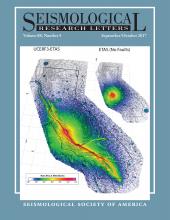 In 2016, three researchers published data they had collected on a series of devastating earthquakes that hit Japan earlier that year.
In 2016, three researchers published data they had collected on a series of devastating earthquakes that hit Japan earlier that year.
But, in late September 2017, one of the authors—Hiroyuki Goto—revealed that the Kumamoto Earthquake data contained “wide reaching errors”—and an outside expert had warned him the data might be problematic nine months earlier.
Goto, an associate professor in the Disaster Prevention Research Institute at Kyoto University, issued two statements in which he acknowledged the errors, but did not indicate how they occurred. According to The Japan Times, Japan’s Ministry of Education, Culture, Sports, Science and Technology is investigating whether the data “was falsified or fabricated due to inconsistencies with other readings taken nearby.” A report in another Japanese paper, The Mainichi, notes that Osaka University—where one of the authors, Yoshiya Hata, works—is looking into the matter as well.
On September 27, Goto issued an official statement about the problematic data, on behalf of the Japan Society of Civil Engineers Earthquake Engineering Committee. One day later, he posted an apology note on his website (both in Japanese and both of which we had translated (1, 2), using One Hour Translation).
In the apology, Goto explained that in late September an outside expert raised concerns about the survey data—first presented in 2016 in the journal Seismological Research Letters. After investigating, Goto confirmed that the data contained “large problems.” Goto also wrote that all affected papers are being withdrawn.
We don’t know the extent to which other researchers have used the data, but, according to The Japan Times article, the impact of the team’s work may be limited. Japan’s science ministry found “no indication that the data in question affected government reports on the quake or related policies.”
The 2016 paper Goto flagged in his apology—“Preliminary analysis of strong ground motions in the heavily damaged zone in Mashiki town, Kumamoto, Japan, during the main shock of the 2016 Kumamoto earthquake (Mw7.0) observed by a dense seismic array”—has been cited five times, according to Clarivate Analytics’ Web of Science (two times by the authors).
We found three other papers about the Kumamoto Earthquake from Goto and Hata (1, 2, 3):
- ”Recovery process of shear wave velocities of volcanic soil in central Mashiki Town after the 2016 Kumamoto earthquake revealed by intermittent measurements of microtremor,” published May 22, 2017 in Earth, Planets and Space, has also been cited once.
- ”Relationships between H/V spectral ratios and damage due to the 2016 Kumamoto earthquake sequence based on microtremor measurements with very high density and wide area in central Mashiki Town, Japan,” published in June 10, 2017 in BUTSURI-TANSA(Geophysical Exploration), has not yet been indexed by Clarivate Analytics’ Web of Science.
- “Nonlinear Site Response at KiK‐net KMMH16 (Mashiki) and Heavily Damaged Sites during the 2016 Mw 7.1 Kumamoto Earthquake, Japan,” published online on July 4, 2017 in Bulletin of the Seismological Society of America, also has not yet been indexed by Clarivate Analytics’ Web of Science.
A spokesperson for the Seismological Society of America, which publishes the Bulletin of the Seismological Society of America and Seismological Research Letters, told us that the publisher is “aware that questions have been raised about the validity of some of the data presented” in two papers (1, 2):
It is our understanding that the University of Osaka is carrying out an investigation regarding the data in these studies. We don’t yet know the status of this investigation, but are awaiting its outcome. The SSA will then consider the appropriate action to take.
Jun Matsushima, the editor-in-chief of BUTSURI-TANSA (Geophysical Exploration), also told us the journal is awaiting the outcome of Osaka University’s investigation before taking action.
“The Situation Could Have Been Avoided”
According to Goto, “this situation could have been avoided” if he had investigated the matter when questions about the data first arose late last year. In his apology letter, Goto acknowledged that “another individual” (who he declined to name) had pointed out a discrepancy in the data on Dec. 19, 2016, before the researchers had published their initial analysis in Seismological Research Letters. In one letter, Goto explained:
If we had sincerely listened at that time and performed a reanalysis, it might have been possible to notice the errors sooner and address them.
But, according to Goto, he and his co-authors thought the discrepancy might be caused by “a special characteristic” of the measurement equipment and thus did not investigate the matter more thoroughly at the time:
For missing this opportunity, and for being unable to meet the standards expected by those receiving the information, we are extremely apologetic.
Goto also apologized to everyone who used the data and “who worked so hard following the Kumamoto Earthquake:”
We had the intention of getting valuable information out to a wide range of researchers and businesses, and to help with the restoration of the community, but the result was the spread of misunderstanding and an increase in the negative impact.
This isn’t the first time earthquake science has made the news: In 2012, six scientists were convicted of manslaughter after downplaying the risks following an earthquake in Italy, which led to some deaths after people failed to seek proper shelter from subsequent tremors. The ruling was overturned in 2015 by an appeal panel.
Hat tip: Author of world fluctuation watch
Like Retraction Watch? Consider making a tax-deductible contribution to support our growth. You can also follow us on Twitter, like us on Facebook, add us to your RSS reader, sign up on our homepage for an email every time there’s a new post, or subscribe to our daily digest. Click here to review our Comments Policy. For a sneak peek at what we’re working on, click here. If you have comments or feedback, you can reach us at [email protected].